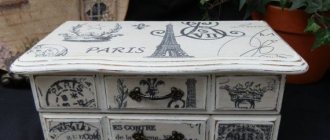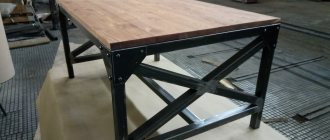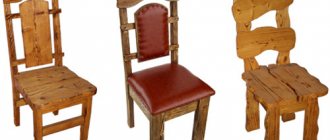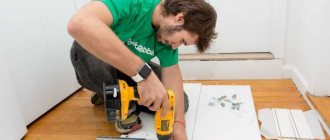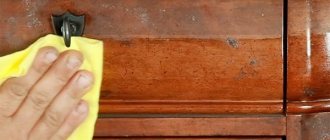Wooden furniture in the house is an indicator of the good taste of the owners and concern for their own health. Wood is an environmentally friendly natural material, absolutely safe for humans. In order for wooden interior items to look attractive longer and not accumulate dust, it is necessary to properly care for them. A tool that helps achieve this is polish. To ensure that taking care of wooden furniture does not harm the health of your household, it is better to prepare furniture polish with your own hands. Since many products for this purpose, located on store shelves, contain harmful substances.
Is polish needed at all?
What is polish used for? The name itself suggests its purpose.
Important! Polish - give a surface a mirror appearance by rubbing.
As a rule, such products are used on varnished furniture, which is the most popular among the entire range of wooden products. Although they are also used to care for unprotected wood - to even out color and texture.
How to choose the right one
In order for the polish to give a noticeable result, you need to know additional selection criteria. This will help you choose a product that not only ideally suits a particular coating, but also does not cause discomfort to the person using it. If the polish does not contain silicone, it means that this product can cover not only a wooden surface, but also marble, plastic, glass and ceramics.
As a rule, conscientious manufacturers care about the convenience of potential consumers and make packaging with polish in the form of sprays, aerosols and creams that are easy to apply, dose, and then close tightly until next use. The popularity of a product can indicate quality. In order to verify the authenticity of the advertisement, you can interview friends who have already used the polish. If the polish is of poor quality, it will be immediately noticeable.
A low-quality composition will not be absorbed into the wood, will leave streaks and greasy marks, and will not mask scratches and minor damage.
It is also important what cloth to rub the polish on the surface with. It should be soft, without buttons, which can worsen the condition of the furniture.
To care for a wooden surface, it is advisable to choose cotton; it does not leave streaks, distributing the polish evenly and efficiently.
Industrial polishes - are they worth buying?
Industrial polishes contain special substances that fill microcracks in the furniture surface, as a result of which the structure of the material becomes even and smooth - polished.
Today, store shelves are filled with a variety of products from different manufacturers. They, to one degree or another, make care easier, but how safe and effective they are is always up to the consumer to evaluate after purchase. This is a matter of personal choice.
Important! It is not uncommon for a manufacturer to promise water-repellent, shockproof and antistatic effects. But in the end you only get disappointment and an unpleasant aftertaste in your soul. Although, for the sake of fairness, it is worth noting that expensive means will indeed provide such a result, but cheap analogues are a game of “believe it or not.”
Furniture wax is a good alternative
You can find furniture wax on the shelves of hardware stores. This substance has been used to coat furniture for centuries. And today it ranks first in wood processing and care.
What are the advantages of using wax:
- furniture can withstand long-term loads;
- wood does not lose its texture, retaining natural warmth;
- the velvety properties of the material are preserved;
- after coating, the color of the product becomes more expressive;
- the ability to choose any tone during restoration;
- The thick consistency fits well on the surface of the wood, filling all cracks and scratches.
Flaws:
- furniture wax should be applied to clean, open-pore furniture (so that there are no paint coatings);
- a labor-intensive process when the surface is varnished (needs to be thoroughly cleaned).
Important! Furniture wax is in most cases used on freshly made furniture, or for thorough restoration of furniture products. When you need to remove a few small scratches or slightly refresh the color, it is better to use a polish with wax or silicone additives.
Wax furniture polish AMWAY™
This is the option when you can trust the manufacturer, because more than one housewife has already noted the effectiveness of this brand’s products for various purposes.
An excellent Amway polish, which has established itself as an ideal assistant for the care of wooden and lacquered furniture.
Important! The creamy aerosol spray consists of a mixture of wax and silicones. After use, the darkened wooden surface acquires its original shine and gloss, and scratches disappear.
Advantages:
- creamy structure - does not flow, does not drip;
- fresh lemon aroma - non-toxic;
- convenient aerosol can;
- easy to use.
What materials can be polished?
As a rule, furniture coating is a varnish layer of one composition or another. In Soviet times, the main type of coating was polyester varnish. It was applied in a thick layer (0.5-0.8 mm), ground and polished on special production lines.
Modern furniture has a varnish coating made on the basis of the same polyester. Or other materials. there are many of them, but the general properties are approximately the same.
The most common coatings are:
- polyester;
- polyurethane;
- nitrocellulose;
- impregnation with oil of natural or synthetic origin.
Almost all varieties can be polished. The softer the varnish, the easier it is to polish, but its abrasion resistance is much lower.
Paints and varnishes that are sold in retail chains are of little use for creating high-quality furniture coatings. They do not meet standards for hardness and load resistance. For restoring furniture coverings, they are suitable only in certain cases and require proper use.
Homemade polish - make it yourself
The advantage of homemade polishes is that you know what ingredients the product consists of. It will not harm your health or your furniture.
Important! For polishing, you need a soft, clean rag made of natural fabric - velvet, wool (you can take a clean, no longer needed wool sock), fleece.
Let's look at several recipes for making polish at home
Recipe 1
This DIY furniture polish recipe is great for items that have been exposed with varnish.
Important! This product will help you clean the surface from dirt. Gives a mirror shine.
Preparation:
- Take 1 cup of olive oil and a quarter cup of lemon juice. You can add a few drops of essential oil to suit your taste.
- Mix well and pour into any container with a lid.
- Apply a few drops to a clean, soft cloth and wipe down the furniture. Remove any remaining grease with a clean, dry cloth.
Important! Store in a cool, dark place. Storage time is not limited.
Recipe 2
By preparing a product for caring for a wooden piece of furniture using this method, you can remove minor damage and microcracks on furniture made from wood that is not varnished.
You will need the following ingredients:
- Vaseline oil - can be replaced with flaxseed oil;
- wax - any wax you can buy (beeswax, soy wax);
- Any essential oil of your choice - you can do without it.
Step-by-step cooking instructions:
- Prepare a water bath - take a saucepan larger in diameter so that a heat-resistant bowl or mug can fit in it. We put a pan of water on the fire and put a bowl or mug in there.
- Melt the butter and wax in a bathhouse, stirring and bringing to a homogeneous consistency.
- Cool slightly and add essential oil, stir.
- Pour into a wide-necked jar, as the mixture hardens after cooling.
Important! When using, apply a thin layer to the wood surface. Rub in circular motions using a cloth.
Recipe 3
This DIY furniture polish removes dust and dirt very well, refreshes the color, and moisturizes the wood. It is prepared like this:
- Take 1 glass of alcohol (medicinal grade) 1 glass of vegetable oil (any you have at home).
- Pour into the bottle and shake well.
- Wet a dry, clean cloth and wipe the surface of the furniture.
Recipe 4
This kitchen appliance care product will help remove greasy stains:
- Prepare a water bath as described above.
- Take 1 glass of beer and 50 grams of beeswax - melt it all, stirring.
- Cool, pour into a jar.
Important! Use chilled:
- Apply a thin layer of product to a clean sponge.
- Wipe the grease stain very well.
Recipe 5
This furniture polish is also easy to make at home. It can be used on wood surfaces that are not varnished.
Prepare for him:
- 75 grams - jojoba oil;
- 45 grams - coconut oil;
- 30 grams - beeswax;
- 30 grams - carnauba wax (can be purchased by ordering in the online store);
- 120 grams - distilled water.
Cooking instructions:
- Melt the oil and wax in a water bath.
- Remove from heat. Pour in water in a thin stream, whisking with a mixer until smooth.
- Apply the cooled mixture to a rag, polish the surface until all the product is absorbed into the wood.
Important! After treatment with a product containing wax, the wood becomes water-repellent. That is, by using such a furniture polish, you thereby extend its service life.
In addition, wax not only protects the wood, but also reveals and emphasizes the beautiful structure of the wood.
Recipe 6
If you do not have the time and opportunity to prepare and select the above recipes, we offer the simplest and most accessible to each of you.
This polish will help restore color, remove microcracks and shallow scratches.
You can quickly make furniture polish with your own hands from an ordinary chicken egg, which you always have in your refrigerator:
- Take 1 chicken egg.
- Add 2 tablespoons of water to it and beat until smooth.
- All is ready. Apply the resulting product to a soft, non-synthetic cloth and rub vigorously into the surface until a shine appears.
Important! The product made from chicken eggs cannot be stored.
Helpful Tips:
- After polishing work, let the material sit for 1-2 hours. Afterwards, wipe with a dry velvet cloth and the surface will become matte.
- By treating wooden furniture using any of the above methods, you will protect it from drying out.
Useful tips
Polishing is a largely creative process. However, it is better to act according to proven methods and not violate technology.
How do you polish? ClassicFolk
It is recommended to follow some tips:
- During operation, do not apply too much force or put pressure on the machine. This may cause the coating to overheat;
- If marks or scratches are clearly visible, you should not start polishing. It is necessary to carefully prepare the surface. sometimes this is neglected, hoping that the flaws will disappear during processing. However, they will remain and will be clearly visible;
- Matte finishes do not polish. Sometimes they become covered with shiny areas, which are restored using scratch paper.
By following these simple tips, you can get high-quality coverage and avoid annoying mistakes.
Furniture polishing is a procedure that allows you to restore old products and correct errors made during operation or transportation. The polishing technology is simple, but high quality can only be achieved with skills and experience. Otherwise, the flaws in the coating will only be exacerbated. If you don’t have confidence in your abilities, it’s better to entrust the work to specialists.
Removing scratches from wood furniture and furniture trim
Very often scratches, cracks or chips appear on the furniture surface.
We will help you make a polish at home that can correct all these errors.
Recipe for light furniture:
- Melt 2 teaspoons of granulated beeswax in a water bath and remove from heat.
- Add 100 grams of soybean oil to the melted wax, beat until smooth.
- Cool, pour into a dry container that closes tightly. The shelf life of this product is up to 6 months.
Important! Before application, clean the surface from dust and dirt. Apply a thin layer to the scratch using a cloth and rub in in a circular motion.
Recipe for dark furniture:
- Take ½ teaspoon of beeswax and melt it in a water bath.
- Add 4 teaspoons soybean oil, 1 teaspoon turpentine, 1 teaspoon lanolin oil, while constantly stirring the entire mixture.
- Remove from heat, cool. Pour into a dry jar.
- Apply in the same way as in the first case.
Important! When cooking, follow fire safety rules. Do not leave turpentine on the fire for a long time - it can easily ignite.
Now you know everything about what polish is for and how to use it on wooden furniture. If you are ready to experiment in order to improve the care of interior items and reduce the cost of purchasing such products, you now have plenty to choose from - recipes with different ingredients, “for every taste,” we have offered you in this article. By following our tips and recipes, your furniture will look well-groomed and beautiful for a long time.
But we don’t say goodbye to you here, come back again!
What is polishing
Polishing is a process of finely treating a surface, giving it shine. As a rule, the varnish layer is polished, but the procedure can also be performed on the paint or the material itself. The processing technique is close to grinding, but the fineness of the abrasive in this case is an order of magnitude higher.
There are different degrees of surface gloss. There are glossy finishes that are highly shiny and reflective to surrounding objects. Furniture finished in this way looks elegant, bright, and glares when exposed to light.
Matte surfaces do not reflect light, their shine is very soft. As a rule, matte types of varnish are used for modern furniture, but ancient samples were coated with a special composition (classic shellac), or the wood was simply impregnated with oil, followed by processing with cloth swabs.
Expert opinion Dmitry Vasilievich Kokovin Furniture restorer There are different technological methods of polishing. The basic method is to apply a special polishing paste to the prepared surface and process it using a polishing wheel made of foam rubber, felt, felt and other materials.
Removing stains from furniture
Stains of various origins can be easily removed with professional products. But if they are not at hand or, for example, there are allergy sufferers in the house, it is better to use less aggressive substances.
- Grease stains. Squeeze out the used black tea infusion, wrap it in cotton cloth and treat the stain, then rub the surface with a soft cloth.
- Fingerprints. Such traces can be removed with a piece of peeled potato.
- Traces of hot dishes. It is necessary to rub the problem area with Vaseline and leave for twelve hours, then wipe off the Vaseline with a cloth.
- Paraffin or wax. Heat the knife blade and remove dirt with the blunt side, then treat the surface with gasoline.
- Traces of flies. Moisten a cotton pad with white wine, treat the occupied areas, and wipe dry.
- Zelenka. Heat a glass of beer, wipe the polish with this liquid, and leave until completely dry. After this, rub the wood with warm wax and polish it with a cloth made of natural wool.
- Wet tracks. Rub the problem area with a strong solution of laundry soap, leave for five minutes, and wipe off.
- Complex spots, the origin of which is unknown. Warm white table vinegar, moisten a soft cloth in it, wash the stain thoroughly, leave until dry and polish. If the stains are old, then ethyl alcohol should be added to the vinegar in equal parts.
Do not clean polished furniture with steel wool, acetone, scouring powder, cologne or nail polish remover. These substances are too active, they corrode the polish and lead to damage to the furniture.
Caring for polished furniture is not as difficult as it might seem. All you have to do is prevent old stains from appearing and use suitable cleaning products. Then tables, cabinets and chairs will delight their owners with their presentable appearance for many years.
Basic Recipes
As a rule, the binder composition is prepared from two parts of stearin, seven parts of chromium oxide, one part of acetic acid. A little kerosene is also added here, just a couple of drops.
There is another interesting recipe for making car polish. Here the base is clay or beeswax. In the second case, you will need to add vegetable oil or turpentine to the product and secure it again with hot wax.
When handling a car body, it is important to always use masks and gloves. A respirator will also work. The required materials are sponges and microfiber cloths. In order to save effort and time, you can purchase a polishing machine for applying the composition.
Varieties
Of the many different polishes produced at home, several stand out as effective and easy to prepare. The ingredients that make up them are found in every home. Polishes are most effective immediately after preparation, so mix the ingredients before use.
Such polishes include compositions based on ammonia, vinegar, olive oil and lemon, as well as wax.
Also, home-made furniture polish is prepared using other simple ingredients, which include Vaseline. Denatured alcohol, turpentine, shellac and lanolin are also suitable for preparing a polishing composition. It is worth noting that they will be less environmentally friendly, which is a disadvantage. The components included in such polishes are difficult to purchase, which makes the preparation process more complicated. When choosing a substance as the main component of the polishing mixture, you need to know exactly what surfaces it is intended for.
With ammonia
A product based on ammonia is suitable for kitchen countertops, bar counters, and painted surfaces. It will protect furniture from dust and remove existing dirt. This composition does not leave cloudy stains after application, which allows you to achieve a mirror shine on glossy surfaces, glass and metal fittings.
The advantage of this composition is its ease of manufacture and availability. To prepare it you will not need anything other than ammonia and water. The product can be stored for a long time, it does not deteriorate and does not lose its original qualities. Among the main disadvantages of such a polish, one can name only an unpleasant odor, but the fact that ammonia contains much less water makes it almost imperceptible. Moreover, the smell of ammonia disappears very quickly.
With vinegar
For lacquered furniture, vinegar-based formulations would be an ideal option. They will return the furniture to its original appearance, degrease its surface, and remove sticky deposits. In addition, vinegar neutralizes alkaline substances such as limescale. Thanks to the use of this product, you can easily deal with marks from mugs and glasses on a wooden table or other surface.
For a standard preparation recipe, you need to use 70% essence as a polishing component. If it is replaced with 9% vinegar, then its amount must be increased accordingly. This composition is stored in a glass or ceramic container. In this case, the period of its use is practically unlimited.
To make polish with vinegar have a pleasant smell, you can add a couple of drops of any essential oil to it. The choice of this component depends only on the preferences of the person who will clean the house.
With olive oil and lemon
The product prepared using olive oil must be used immediately; storing it is not recommended. It is strictly forbidden to use olive oil-based polish on varnished surfaces. This is explained by the fact that the top layer of varnish will not allow the oil to be absorbed; it completely remains on the surface, making it greasy. In addition, using this composition on antique furniture that has a delicate finish may cause a “haze” to appear on it. In order to find out how the surface will behave after exposure to the composition, first use it on a small area in an inconspicuous place.
If it was not possible to polish the surface to the required condition the first time, then after a short period of time you can reapply the composition and perform all the steps again. In this case, the first portion of the product will have time to be absorbed into the wooden surface, and the second will give it shine.
Wax based
Wax-based polishing compounds are designed not only to prevent dust from settling and to add shine to the surface, but also to mask small defects: shallow scratches and chips. Wax fills them in, making them less noticeable. The use of such a product ensures that there is no need for frequent application - the wax film does not wear off from the treated area for a long time. The disadvantage of this composition is the appearance of fingerprints visible to the eye after any touch.
Essential oils are often added to wax-based polishes. This is done because they disinfect the surface being treated. For these purposes, certain types of essential oils are used: lavender, eucalyptus, oregano, juniper, clove, tea tree, cintronella and thyme. In addition, tea tree oil helps get rid of mold.
Other types
Compositions with denatured alcohol, turpentine and shellac are less safe for humans compared to the above. Their use is comparable to the use of conventional store-bought polishes. Such compositions are used when all the necessary ingredients are in the house, but it is not possible to buy a regular polish. But despite this, it is these components that have enhanced cleaning properties, and if compositions with vinegar, ammonia or wax fail to deal with dirt and polish furniture, then a small amount of denatured alcohol is added to them. After this, removing dirt from the surface is very quick and easy. In addition, such compositions provide good surface disinfection and help remove fungus and mold, which in some cases is simply necessary. A good example of such an application is cleaning the bathroom, where there may also be wooden furniture.
Cleaning becomes enjoyable
If, reading the previous lines, you recognized yourself in them, then it was not in vain that I started writing this article. If, on the contrary, you wanted to urgently come to my house to put things in order, then this article is also for you. I believe cleaning can be an enjoyable experience for everyone by applying a few simple tips.
The first thing that helped me make cleaning more bearable were principles taken from the book “The Magic of Tidying Up” by author Marie Kondo.
This book focuses on the need to get rid of unnecessary things that do not bring you benefit or joy. Now I will give a few principles told by Marie Kondo that will help bring order.
Applying varnish
Let's talk about which varnishes are best to use. The best are considered alkyd (Tikkurila Unika-super series), polyurethane and water-polymer (good ones are Swedish Bask).
Despite the lack of odor, water-based varnish is not the best choice for your first varnishing experience. Essentially it is a water-based suspension. But it is far from being as harmless as is commonly believed. Water-based varnishes contain very harmful solvents, albeit in small quantities. It’s just that the usual acetone and others cannot keep such a composition in a stable state. So we have to use much “cooler” solvents.
This is by the way, but the reason is essentially different - difficulties during processing. When applying varnish, water is absorbed into the wood fibers and they rise. As a result, after the first treatment, the surface is far from smooth, but very rough. This effect is especially pronounced on pine products. So after the first layer of water-based varnish has dried, take an angle grinder or a sander, attach 320-grit sandpaper to it and sand it until smooth. If you're lucky, the next layer will lie flat and the pile won't rise again; if not, you'll have to repeat the operation again. The situation is not fatal, of course, but unpleasant. This does not happen with other varnishes.
How to apply varnish
Now a little about how to apply varnish. Professionals believe that the best method is spraying from a spray gun. This may be true, but not all home craftsmen have such a device, and you also need to be able to work with a spray gun. Among manual application methods, a popular method is application with a piece of foam rubber (or a new kitchen sponge) or a fabric swab (soft, white, lint-free fabric). To decide, you need to try what is more convenient for you, how it turns out smoother (if it works out at all).
The next method is with a small foam roller. Suitable if you are varnishing a surface of a simple shape without small details (a door leaf, for example).
Applying varnish with a brush is the most unpopular method
The use of brushes when varnishing furniture, oddly enough, is in last place. The fact is that it is difficult to evenly apply a layer of varnish in this way. You need a good brush with soft, thick, natural bristles, which should not tangle under any circumstances.
Technology
Regardless of the chosen method of applying varnish, its layers should be thin and of uniform thickness. Take a little product onto a brush/sponge/roller/tampon and rub it over the surface as thoroughly as possible. Next time we dip it in varnish only after the “weapon” no longer leaves any traces. In this way we cover the entire surface and leave to dry.
Many coats of varnish may be required
The applied layer of varnish does not dry completely, but the time indicated on the packaging of the varnish in the column “tack-free” or “application of the next layer”. On average, for water-based varnishes it is 1 hour, for alkyd varnishes - 5 hours. The next layer is applied using the same technique. The total number of layers is usually from 5 to 9, depending on the quality of the veneer and preliminary sanding. When the surface becomes absolutely smooth, the varnish is dried until completely dry - 2-3 days. After this, sanding begins again.
Self-cooking
First of all, you should know that every polish must contain an abrasive substance. You also need to add a component for the binder or base, it can be liquid or silicone. To prepare an abrasive, you need to do the following. Prepare chrome-containing paint and burn about 200 grams of it using a soldering iron or flame. Ammonium dichromate can be used instead of paint. The production of the binding component occurs as follows:
Traditional methods of cleaning lacquered furniture
In addition to expensive chemical polishes, which often have a very strong odor and are poorly tolerated by people with allergies, you can use folk remedies to clean furniture at home. Few people know that it is possible to renew the varnished surface of a table or bedside table, remove stains left by hot objects, or wipe off droplets of wax and glue with the help of flour, table vinegar, soap, milk and other products that are always found in the household.
Fresh spots
Oily finger stains stand out especially strongly on shiny surfaces. Furniture covered with such prints looks sloppy. There are several techniques to quickly get rid of traces of grease on polishing:
- A piece of laundry soap is soaked in water and the surface of the furniture is wiped with a soft cloth soaked in a soap solution.
- Grease stains are lightly sprinkled with flour, talcum powder or baby powder. Wait 10–15 minutes until the bulk product absorbs the fat, then wipe with a soft, clean cloth.
- Rub the contaminated surface with a potato tuber cut in half. 15 minutes after treatment, polish the table with a cotton cloth.
- Mix alcohol and vegetable oil, taking equal amounts of ingredients, and rub the furniture with this mixture.
- You can wash lacquered furniture with milk. Soak a napkin in milk, wring it out and wipe the area of contamination. Remaining liquid is removed with a dry cloth.
Whatever cleaning product is used, the job should always be completed by polishing to a high shine using a soft flannel.
Old pollution
To remove old stains, you will have to use more aggressive products with salt and acid.
- Using table salt you can remove marks left by hot dishes. To do this, wrap a handful of salt in a handkerchief, moisten the bag in vegetable oil and rub the damaged surface.
- Old stains are removed with 9% vinegar. If you leave acid on a furniture surface for a long time, the varnish may crack, so you need to act as quickly as possible, and after cleaning, carefully remove any remaining vinegar with a dry cloth.
- To clean the polish, tea leaves are useful. After drinking tea, put it in a cloth and wipe the furniture.
- Sauerkraut brine is a great way to remove dirty stains from polish.
Droplets of frozen wax that accidentally fall on the polished table during the celebration should be cleaned off with a wooden stick or spatula, and then wipe the area of contamination with a swab soaked in vinegar.
How to remove dirt from polished furniture
To wash dirt from home furniture, you can use a special chemical solution from the manufacturer or improvised materials. You can even wash the surface with tooth powder dissolved in ammonia.
It is also necessary to prepare means for treating the surface of the product.
Preparation of a special solution
To remove dirt from polished furniture, you can use a special solution and antistatic agent for clothing, hair shampoo and several glasses of water at room temperature.
Folk remedies are suitable for preventive cleaning.
The resulting mixture will get rid of stubborn stains, grease and dust.
Use of beer
Beer is an excellent way to remove ink stains, stubborn dirt, grease and paint marks. A dark, intoxicating drink can remove ink, and a light drink with added sugar can remove fat and the rest.
Photo: example of a polished table before and after.When using beer as a cleaning agent, remember that furniture polishing does not tolerate icy liquids.
Olive oil or wine vinegar
If small scratches appear on the surface, it is recommended to use a mixture of olive oil and wine vinegar (or maybe some red wine).
The oil can be used on almost any surface, except those that are highly absorbent.
After mixing the solution, apply the mixture to the surface and rub it with an old toothbrush. After a few minutes, you need to wipe the cabinet or table with a flannel napkin.
Oil protects wood from moisture.
Burr oil
You can quickly remove dirt, greasy stains or white marks from varnished furniture with burdock and linseed oil. A mixture of pure gasoline, denatured alcohol and the indicated oils will be useful. It will help remove grease, stubborn dirt, scratches, paint marks, pen marks and a number of other troubles.
Polishing furniture improves its appearance and improves many functional characteristics.
In this case, the smell of the infusion will help remove denatured alcohol and a cloth napkin.
Tea brewing
Tea leaves will also be useful in removing dirt and cleaning polished furniture. To use it, you need to wrap the used tea mixture in a paper towel.
Tea leaves will help improve the appearance of furniture.
Use the resulting bundle to wipe the stained area and, as the stains are removed, wipe the table, cabinet and other object with a dry rag.

